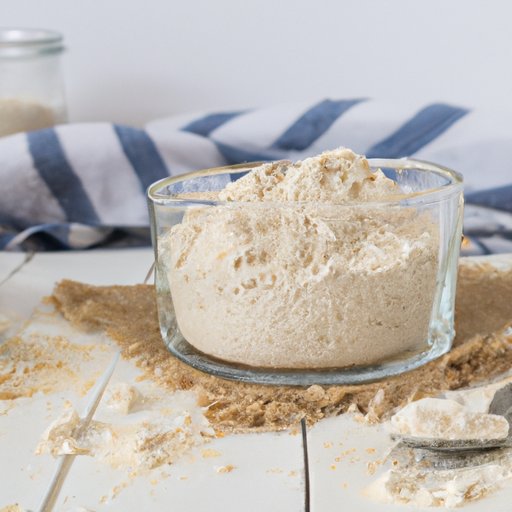
I. Introduction
Oat flour is a nutritious, flavorful, and versatile alternative to traditional flours. Made by grinding rolled oats, it’s a great source of fiber, protein and a host of vitamins and minerals. For people on gluten-free diets or those who want to incorporate more whole grains into their meals, oat flour is an excellent choice. Unfortunately, it’s not always available in stores, leaving many home cooks in a bind. Fortunately, making oat flour at home is easy, cost-effective, and has many benefits.
II. Step-by-Step Guide to Making Oat Flour
Ingredients and Equipment Needed:
- Old-fashioned rolled oats
- A food processor or high-speed blender
- Airtight container for storing the flour
Blending Instructions:
- Place the old-fashioned rolled oats into a food processor or high-speed blender.
- Grind them until they are a fine powder-like consistency.
- Pulse the oats for a few more seconds until the flour is even finer.
- Transfer the oat flour to an airtight container for storing.
Tips for Ensuring the Oat Flour is the Right Consistency:
- Use rolled oats rather than quick-cooking oats, which won’t grind as fine.
- Make sure to grind only a small portion at a time to ensure an even grind and avoid overheating the machine.
- For a lighter texture, sift the flour through a fine-mesh sieve before using it in your recipe.
III. Recipes Using Oat Flour
The beauty of oat flour is its versatility. Its nutty, slightly sweet flavor makes it an excellent addition to both sweet and savory dishes. Because it has no overpowering taste, it’s easy to incorporate into various recipes. Here are some recipe ideas to get you started:
1. Pancakes and Waffles
Swap out some or all of the flour in your favorite pancake or waffle recipe for oat flour. The result is pancakes or waffles that are fluffy and tender.
2. Bread
Oat flour can enhance the texture and nutrition of homemade bread. For example, try making oat flour sandwich bread by substituting half of the all-purpose flour with oat flour.
3. Sweet Options
Oat flour is great for sweet treats like cookies, muffins, and cakes. Blending the flour with a little bit of cornstarch or potato starch can help mimic the structure of wheat flour, producing a desirable result.
4. Savory Options
Oat flour works well in savory dishes, too. For example, add it to homemade pasta dough for a more nutritious and flavorful result. It’s also a great addition to veggie burger patties or meatballs, providing both texture and nutrition.
IV. Comparison with Other Flours
Compared to traditional wheat flour, oat flour has a lower glycemic index, meaning it won’t cause blood sugar spikes. Oat flour is also naturally gluten-free, making it an excellent choice for anyone with celiac disease or gluten intolerance. Additionally, oat flour is a good source of fiber, providing 4 grams per quarter cup.
However, oat flour has a slightly nuttier flavor and a denser texture than white flour. It’s also slightly stickier due to its high fiber content, so it may cause some stickiness during handling. When baking with oat flour, it’s best to use recipes designed specifically for it or experiment with your substitutions.
V. Gluten-Free Option
Oat flour is a great choice for anyone on a gluten-free diet. However, it’s essential to make sure the oats are gluten-free. Although oats themselves do not contain gluten, they are frequently contaminated during processing or transport.
Therefore, it’s best to look for certified gluten-free oats or oat flour to ensure a safe and healthy product. With certified gluten-free oats, homemade oat flour can reliably be used in place of wheat flour in most recipes, including bread, muffins, pancakes, waffles, and piecrusts.
Gluten-Free Recipe Ideas
- Gluten-free oat flour banana pancakes
- Strawberry oat flour muffins
- Gluten-free oat flour pizza crust
- Chocolate chip oat flour cookies
- Gluten-free oat flour banana bread
VI. Using Homemade Oat Flour in Baking
Oat flour may be used as a 1:1 substitution for wheat flour in most recipes. It’s important to remember that oat flour will produce a more dense and chewier result in baked goods than wheat flour.
To avoid a heavy, dense texture, try swapping half of the white flour in your recipe for oat flour. Alternatively, blend oat flour with gluten-free flour mixtures to create a lighter, fluffier texture.
Homemade oat flour can be substituted in curries, soups and stews as a thickening agent for the final product. The high fiber content helps to thicken the stew, helping to create a richer and more substantial dish.
VII. How to Store Homemade Oat Flour
Homemade oat flour should be stored in an airtight container in a cool, dry place like a pantry.
You can also store oat flour in the freezer to keep it fresh for longer. If you choose to store it in the freezer, make sure it’s in an airtight container or a heavy-duty freezer bag.
Finally, for a fun DIY project, you can use oat flour to make your own facial masks and body scrubs.
VIII. Conclusion
Learning how to make oat flour is easy and can benefit your health and wallet. It’s an excellent addition to any diet and can be used in a variety of recipes that both sweet and savory. Whether you’re exploring gluten-free options or adding whole grains to your diet, oat flour is a delicious, nutritious choice.
So, experiment with your homemade oat flour and see how easy it is to incorporate it into your favorite recipes.





